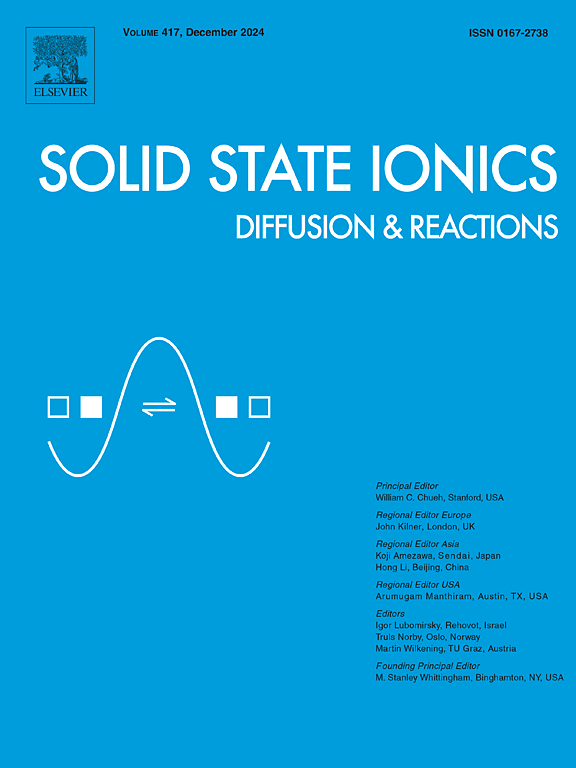Ca1−xSrxMnO3−δ颗粒、球团、泡沫:制备条件和微观结构对氧化动力学的影响
IF 3
4区 材料科学
Q3 CHEMISTRY, PHYSICAL
引用次数: 0
摘要
微观结构和氧化动力学是密切相关的因素,显著影响材料在氧化环境中的行为。这种关系对于氧化还原材料(如Ca1−xSrxMnO3−δ)尤其重要,其中可逆氧离子交换和氧化态转移是其功能的关键。在第一项研究中,利用扫描电子显微镜(SEM)研究了不同锶含量对Ca1−xSrxMnO3−δ粉末组成的形貌和微观结构的影响。结果表明,随着锶含量的增加,颗粒尺寸变小,颗粒均匀性得到改善。锶浓度在0 ~ 40%之间的颗粒表现出明显的形态变化。微孔隙度和d50随锶浓度的变化呈非单调变化,无明显的变化趋势。第二项研究探讨了宏观结构形式(如泡沫和颗粒)如何影响Ca0.8Sr0.2MnO3−δ中的氧化动力学。分析了原料粒度分布、总体微孔隙率和宏观结构特征等参数对氧化速率的影响。研究结果表明,宏观结构构型以及微观结构特征(如微孔隙度)显著影响氧化动力学。这些研究共同强调了掺杂剂浓度、微观结构特征和结构形态在决定Ca1−xSrxMnO3−δ氧化行为中的关键关系,为优化氧化还原环境下的材料性能提供了关键见解。本文章由计算机程序翻译,如有差异,请以英文原文为准。
Ca1−xSrxMnO3−δ granules, pellets, foams: Influence of fabrication conditions and microstructure on oxidation kinetics
Microstructure and oxidation kinetics are closely intertwined factors that significantly influence the behavior of materials in oxidative environments. This relationship is of particular importance for redox materials such as , where reversible oxygen ions exchange and oxidation state shifts are key to their functionality. In the first study, scanning electron microscope (SEM) was used to examine how varying Sr content affects the morphology and microstructure of powder compositions. The results indicate that increasing Sr content leads to smaller particle sizes and improved particle size homogeneity. Granules with Sr concentrations ranging from 0 % to 40 % exhibit notable changes in morphology. However, the microporosity and d50 vary slightly across the samples in a non-monotonic manner, with no clear trend emerging with respect to Sr concentration. The second study investigates how macrostructural forms, such as foams and pellets, impact oxidation kinetics in . Parameters including particle size distribution of the raw material, overall microporosity, and structural characteristics of these macrostructures were analyzed for their effect on oxidation rates. Findings reveal that macrostructural configuration, alongside microstructural features like microporosity, significantly impacts oxidation kinetics. These studies collectively underscore the critical relationship between dopant concentration, microstructural characteristics, and structural morphology in determining the oxidative behavior of , providing key insights into optimizing material performance in redox environments.
求助全文
通过发布文献求助,成功后即可免费获取论文全文。
去求助
来源期刊

Solid State Ionics
物理-物理:凝聚态物理
CiteScore
6.10
自引率
3.10%
发文量
152
审稿时长
58 days
期刊介绍:
This interdisciplinary journal is devoted to the physics, chemistry and materials science of diffusion, mass transport, and reactivity of solids. The major part of each issue is devoted to articles on:
(i) physics and chemistry of defects in solids;
(ii) reactions in and on solids, e.g. intercalation, corrosion, oxidation, sintering;
(iii) ion transport measurements, mechanisms and theory;
(iv) solid state electrochemistry;
(v) ionically-electronically mixed conducting solids.
Related technological applications are also included, provided their characteristics are interpreted in terms of the basic solid state properties.
Review papers and relevant symposium proceedings are welcome.
 求助内容:
求助内容: 应助结果提醒方式:
应助结果提醒方式:


